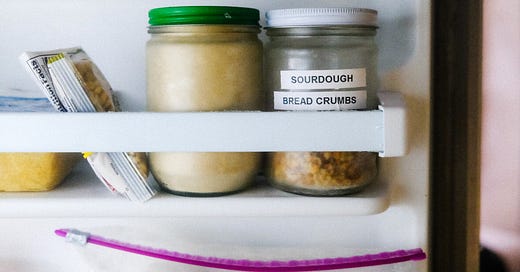Since starting this newsletter, a few people in my real life have told me how they can’t shop, eat, or cook like I do. I have found these personal admissions a bit puzzling—I don’t believe how I eat and cook is how everyone else should.
I’m self-aware enough to know this impulse says little about me and this (tiny) newsletter and more, I think, about the anxiety and powerlessness that working people are experiencing en masse. One of the many byproducts of this is the disconnection between the average person and the food they eat. Not just the literal origin of their food (though that’s a problem) or the nutritional misinformation that 50 years of diet fads have profited from, but also the burden of it all. Three meals a day if you feed just yourself, and extra coordination and work if you feed more.
Food is not simple. Food, especially right now, is expensive. If we are to be thorough—food is triggering. Food is contextual. Managing, buying, and cooking food is, unfortunately, patriarchal. For most of us, cooking healthy, real food is time-consuming and never-ending.
I understand the desire to defend one’s lifestyle, especially when your life feels like a delicate balance of limited choices. And while I don’t think we (I mean, quite literally, you and me) will cook ourselves out of the climate crisis, I don’t think it’s justified either to fool ourselves into believing that since the food system is so complex, choiceless, and out of our control, it is therefore neutral.
If I were to defend home cooking, I would say this: effort and labor aren’t always extractive. Cooking from scratch and outside the industrial food system, when possible, is more work than a meal of pesticide-ridden and ultra-processed ingredients. But it’s not (necessarily!) home-baked bread and summer weekends spent canning, either. Cooking and eating for this planet and its people can look a hundred distinct ways.
We all have different options, but nearly every one of us has options. You might have a large backyard garden, and I might have a dishwasher. You might have a wonderful local bakery, and I might have storage space for bulk food. I might not eat meat, but you might have a direct source for pasture-raised chicken. I might have a flexible grocery budget, and you might have an easily accessible farm share. Different options, but options.
I have been thinking about this phenomenon beyond my newsletter, too, after reading a few well-meaning defenses of ultra-processed food and seeing a food scientist defend pesticides. The righteous desire to defend people with no options, or to blanketly avoid shaming and fear-mongering, clouds over the reality of the options the average home cook does have. Home cooking is only made possible with creativity and imagination.
My hope with this newsletter is that it does not feel like a judgmental prescription but rather a look at one cook’s approach, to take and pick for your own, because it is imperative for your health and the planet’s.
This was an unintended (and long-winded!) way to introduce a new series called Whole-Food Pantry, where I’ll write about simple ways to build and maintain a straightforward, whole-food pantry. Let’s start with an easy one: breadcrumbs.
Frozen Sourdough Breadcrumbs
Breadcrumbs require almost no effort, and the payoff is significant. Try making a breadcrumb-forward recipe like Sheet-Pan Roasted Broccoli Pasta with store-bought panko and then again with homemade. You will never go back.
Use the bread you have—I like sourdough for the depth of flavor. This is a great way to use up stale bread or the butts of loaves.
The freezer is your preservative; you can take them directly from the freezer to toast them on the stovetop—no thawing necessary.
Ingredients and tools
Bread
High-speed blender OR food processor
Instructions
Cut or tear bread into bite-size pieces and place in a single layer on a dinner plate or baking sheet. Leave it on the counter, out of the way of moisture and curious hands.
Depending on the humidity of your home and the bread’s hydration, leave the bread out to stale for one to three days. You are looking for bread pieces that are dry and staling but still slightly pliable.
In a blender or food processor, blitz the bread until the crumbs are your desired size.
Store in a lidded jar in the freezer.
When ready to use, heat a dry pan on the stove over medium-high heat and toast the breadcrumbs until golden brown, stirring every 30 seconds or so. They can toast quickly, so keep an eye on it!
Notes
The breadcrumbs can last in the freezer for up to six months.




I love your concept. As a health coach with a background in nutrition, I just touched on this idea in one of my Substacks. Are you paying for someone else to make your food? Whether it’s in a package or takeout, someone else made that food. Even if it’s super simple stuff, you making your own food is like a freaking religion. You choose what goes in. You learn how to use spices. You work on your palate. And all of this can be done in a way that isn’t time consuming (and will save you money and cut down on waste!). Keep going, I’m rooting for you!
Also love this sentiment and homemade breadcrumbs is a favourite hack. I save the ends of sourdough loaves and blitz once they've accumulated a bit and I desperately require the freezer space again. Got a favourite kale and leek bake recipe that these add a bit of crunch to and they taste even better when your sourdough is of the seeded variety.